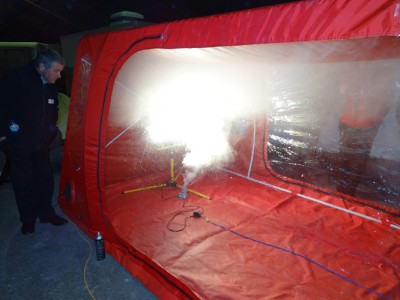Post remediation verification
 The first issue regrding toxic mould decontamination is that most industry best practice doesnt work.
The first issue regrding toxic mould decontamination is that most industry best practice doesnt work.- The historic protocol of bleach and wiping off mould growth simply doesnt work.
- First of all no single chemical can kill or destroy all mould forms
- Airborne contamination is the greatest hazard and wilth 1 billion spores in a cubic inch and hazard levels recognised at 500 you can see the risk.
- Air cleaning of sub micron contaminates by conventional filtration methods is impossible and below you will see justification of this statement
The photo above is an experiment we use to show why contamination stratifies and in this 1000 cubic feet enclosure we have a 500cfm Negative Pressure Unit pulling air out. In two minutes the smoke should be gone but after 20 minutes it was still there with only lower levels removed.
We can clean and decontaminate the air in buildings within hours using state of art world leading chemical air scrubbing products.
We have previously mentioned that all mould is allergenic and some can produce toxins.
The NHS have provided sensible guidance regrding mould removal (see link)
.It should be noted that black and Toxic moulds are misnomers and the colour of mould is no indication of toxicicty and even moulds known to be toxic do not always release toxins.
When removing significant areas of mould, critical barriers should be errected with negative or positive air differential pressures used to control or eliminate spore and mycotoxin spread to other previously uncontaminated areas. The international guidelines identify levels of contamination although the levels of clearance or post remediation levels are not provided and are for the environmental hygienist to determine.We can assist in this process if you use your own contractors. Critical barriers with air locks are standard for any but the smallest decontamination projects.Air locks for entry and exit are also reccomended. We provide all equipement and protocols based on recognised and internationally recognised standard operating procedures.
Post remediation or clearance
Following competent decontamination or mould removal, the affected area should be assessed for cleanliness and mould removal success.
Visual surveys are the first objective and the sign of any dust or debris is an indicator of poor controls. The second test is air and particle counters will assess the air dust levels. Obviously if there is a lot of dust in the air it can be assumed that spores are present too and that dust suppression or indeed removal has not taken place. The next test can be on site mould air and surface sampling. This test can assess the quantity but not species of mould but can identify non viable or dead mould which is probably more of a health risk than live or viable mould spores. The final test will be comparison between different areas and agreed base lines. We at “Toxic Mould” can provide all services for both decontamination and post remediation verification. If you use any contractor to remove mould you should demand verified evidence (sometimes third party and independent) that they have actually decontaminated the areas and not simply killed the mould or just removed the visible contamination. Clearance includes air sampling and inhalation is the greatest hazard and risk
Why conventional decontamination doesn’t work
Historically decontamination has been achieved by cleaning and or application of fungicides. The forgoing has shown that dead mould and baiological fragments are even more hamful than active surface growth.
The inhalation risk is possibly the greatest helath concern unless you eat surface mould.
Air decontamination is poorly understood and the HSE have published a document which shows why bio aerosols can remain airborne and why HEPA and air cleaners don’t really work (See HSE link)


